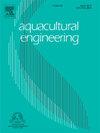Hydrodynamic characteristics analysis of series hydraulic cyclone separators for pond aquaculture wastewater purification
Abstract
This study introduces a series of hydraulic cyclone separators designed to efficiently remove sediments and other high-density particulate matter from pond aquaculture wastewater. A three-dimensional two-phase model of these hydraulic cyclone separators was developed using the discrete phase model (DPM) and Reynolds stress turbulence model (RSM) based on numerical simulation theory. The computational fluid dynamics (CFD) method was validated by comparing it with experimental data, and an analysis of the hydrodynamic characteristics of the hydraulic cyclone separators was conducted. Furthermore, the relationships between structural parameters and separation efficiency were examined using Pearson's correlation coefficient. The findings reveal that the length of the first-stage cyclone column significantly influences the tangential velocity distribution within the second-stage cyclone, while the length of the second-stage cyclone column predominantly affects the pressure distribution of the first-stage cyclone. Increasing the column length enhances the overall particulate separation efficiency of the system. Moreover, adjustments in the split ratio of the first-stage cyclone have a notable impact on the tangential velocity and pressure distribution within the second-stage cyclone. Increasing the split ratio proves beneficial in improving the separation efficiency of particulate matter. This study provides valuable insights into the design and optimization of hydraulic cyclone separators, offering a dependable computational model for predicting and understanding their flow behavior and separation performance effectively.

 求助内容:
求助内容: 应助结果提醒方式:
应助结果提醒方式:


